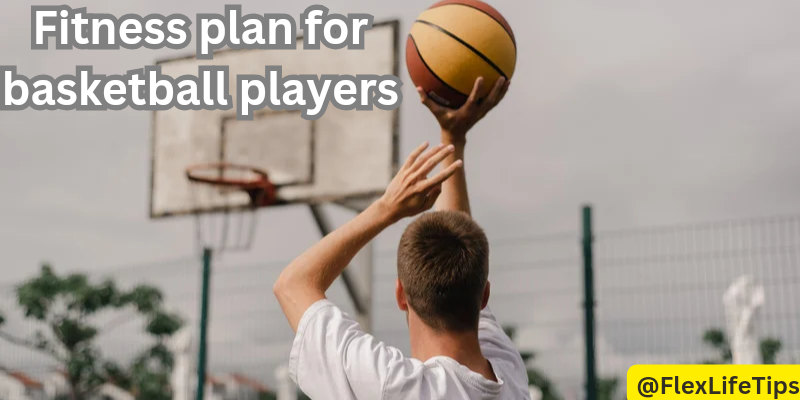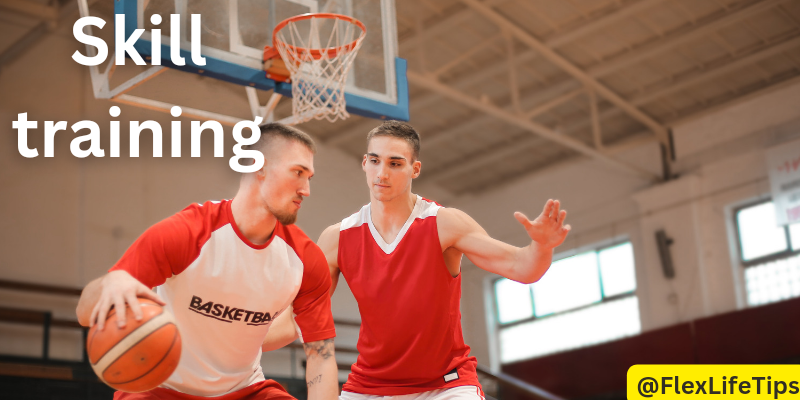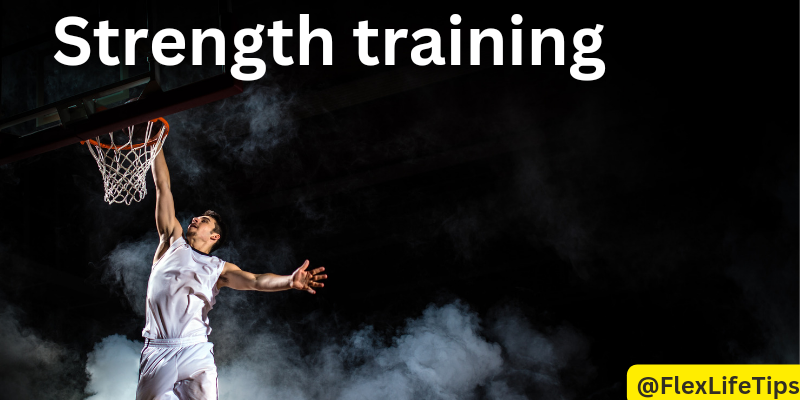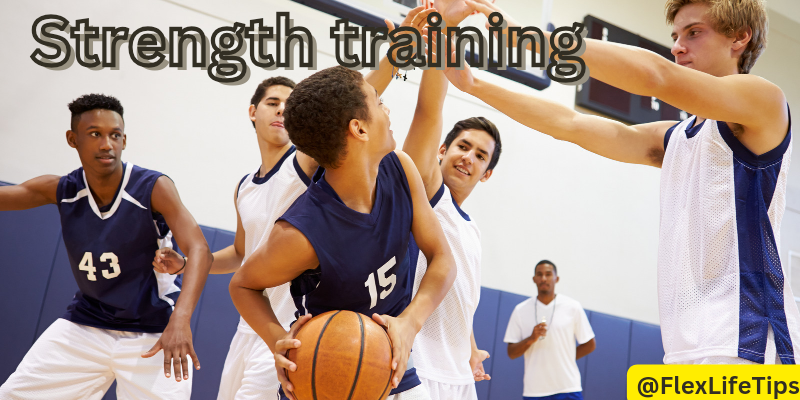Discover the ultimate fitness plan for basketball players to optimize performance. Tailored workouts for skills, strength, and endurance. Elevate your game with our proven strategies
Introduction:
In the dynamic world of basketball, where agility, endurance, and skill are paramount, a well-designed Fitness Plan for Basketball Players serves as the cornerstone for success on the court. This comprehensive plan encompasses a strategic blend of workouts tailored specifically to the demands of basketball, aiming to enhance players’ physical attributes, refine their skills, and elevate their overall performance.

From strength training to agility drills, this fitness regimen is meticulously crafted to optimize players’ capabilities, enabling them to excel in every aspect of the game. Join us as we delve into the intricacies of crafting an effective Fitness Plan for Basketball Players, unlocking the pathway to peak athleticism and on-court dominance.
Structuring Your Training Schedule

The Importance of a Flexible Approach
A good fitness plan for basketball players needs to be flexible. This means being able to adjust your workouts based on what’s happening in your life. Some days you might have more time and energy to train hard, while other days you might need to take it easy. It’s all about finding a balance that works for you.
Balancing Intense and Light Training Sessions
In basketball, it’s important to have a mix of intense and lighter training sessions. The speaker suggests that on Mondays and Wednesdays, players should focus on intense workouts where they push themselves hard. These are the days for practicing with a partner or small group and really honing in on specific skills. On Tuesdays and Thursdays, the intensity dials back a bit with lighter, more varied workouts. These sessions are still important for maintaining skills but don’t require as much effort.
Adapting to Individual Needs
Every player is different, so it’s important to adapt your training schedule to fit your own needs. Some players might thrive with intense workouts every day, while others might need more rest and recovery time. By listening to your body and being flexible with your training, you can find what works best for you and maximize your performance on the court.
Skills Training Workouts
Basketball players need to focus on developing their skills to excel on the court. Here’s how the speaker breaks down the training schedule for honing these abilities:

Monday and Wednesday: Intense Training Sessions
On Mondays and Wednesdays, it’s time to push yourself hard. These are the days for intense training sessions where you really dive deep into improving your skills. The speaker suggests working with a partner or a small group to simulate game situations and practice defense. By focusing on two to three key areas, players can make significant strides in their development. These sessions typically last between an hour to an hour and a half, ensuring ample time for improvement.
Tuesday and Thursday: Lighter Skills Training
Tuesdays and Thursdays offer a chance to dial back the intensity slightly while still working on skills. These sessions are lighter and shorter but are still crucial for maintaining and refining your abilities. The focus here is on covering various skill areas, such as ball handling, shooting, and agility. Players can customize these workouts to suit their needs, whether it’s alternating between different drills or focusing on specific aspects of their game. Keeping these sessions around 45 minutes ensures players stay sharp without overexerting themselves.
Incorporating Various Skill Areas
It’s important to incorporate a range of skill areas into your training regimen. This ensures that you’re well-rounded and prepared for any situation on the court. Whether it’s practicing ball handling, working on your touch around the rim, or fine-tuning your shooting technique, each skill area contributes to your overall performance as a basketball player. By dedicating time to develop these skills consistently, players can elevate their game and become more effective on the court.
Flex Day
Friday serves as a flexible day in your training schedule, allowing you to listen to your body and adjust accordingly. Here’s how the speaker explains the importance of this day:
Friday: Listening to Your Body and Adjusting Accordingly
By the end of the week, players may feel varying levels of fatigue or energy. Friday is the day to tune into your body’s signals and make decisions based on how you’re feeling. If you’re feeling tired after a long week of training, it’s okay to opt for a lighter workout similar to those on Tuesday and Thursday. On the other hand, if you’re feeling energized and ready to go, you can push yourself with a more intense session similar to those on Monday and Wednesday. This flexibility allows you to adapt your training to your current state, ensuring that you’re not overexerting yourself and risking injury.
Embracing Flexibility in Training
Flexibility is a key component of any successful training regimen. It’s important to recognize that not every day will go according to plan, and that’s okay. By being flexible and open to adjusting your workouts as needed, you can better accommodate changes in your schedule, energy levels, and physical condition. This approach ensures that you’re able to maintain consistency in your training while also prioritizing your overall well-being and performance on the court.
Strength Training Routine
Strength training is a crucial aspect of a basketball player’s fitness plan, helping to build muscle, improve performance, and prevent injuries. Here’s how the speaker breaks down the strength training routine:

Matching Intensity with On-Court Workouts
To get the most out of your strength training, it’s important to match the intensity with your on-court workouts. The speaker suggests aligning the intensity of your strength training sessions with the intensity of your on-court sessions. This means that on days when you have intense on-court workouts, such as Mondays, Wednesdays, and possibly Fridays, your strength training sessions should also be more intense. Conversely, on lighter on-court workout days, like Tuesdays and Thursdays, your strength training sessions can be lighter as well. This ensures that you’re giving your body the appropriate amount of stress and recovery time to optimize your performance and progress.
Consolidating Stress for Optimal Recovery
Consolidating stress is a key concept in the strength training routine. Instead of spreading out intense workouts evenly throughout the week, the speaker suggests consolidating them on specific days, such as Mondays, Wednesdays, and Fridays. By doing this, you give your body more time to recover between intense workouts, which can lead to better results and reduce the risk of overtraining or burnout. This approach allows you to push yourself hard during your strength training sessions while still giving your body the rest and recovery it needs to perform at its best on the court.
Weekly Strength Training Structure
Here’s a breakdown of the weekly strength training structure recommended by the speaker:

Monday: Power-Based Workouts
Monday is the day for power-based workouts. This means focusing on exercises that help you build explosive strength and speed. By starting the week with power-based workouts, you can take advantage of the rest you’ve had over the weekend and push your body to move fast and generate power. Examples of exercises for power-based workouts include plyometrics, Olympic lifts, and explosive movements like medicine ball throws. These exercises help develop the quickness and agility needed for basketball players to outmaneuver their opponents on the court.
Wednesday: Shorter, Heavier Strength Sessions
Wednesday’s strength training session is shorter but heavier. This means lifting heavier weights with fewer repetitions to build muscle strength and endurance. The speaker suggests keeping the workout shorter to prevent overtaxing your body mid-week while still providing a challenging stimulus for muscle growth. Exercises for this session may include compound movements like squats, deadlifts, and bench presses performed with heavier weights and lower reps. By focusing on heavier lifting, you can continue to build strength and resilience throughout the week.
Friday: Higher Reps for End-of-Week Push
As the week comes to a close, Friday’s strength training session focuses on higher reps to push your muscles to fatigue. This helps to enhance muscular endurance and stamina, preparing you for the demands of end-of-week games or practices. While the weights may be lighter compared to Monday and Wednesday, the emphasis is on completing more repetitions to challenge your muscles and push them beyond their limits. Exercises for this session may include variations of bodyweight exercises, machine exercises, or lighter free-weight movements performed for higher reps. This end-of-week push helps to ensure that you finish the week strong and maintain your progress in strength and conditioning.
Incorporating Pickup Games
Engaging in pickup games is a vital aspect of a basketball player’s training regimen. Here’s why:

The Importance of Game Simulation
Pickup games provide invaluable opportunities for players to simulate real game situations. Unlike drills or structured practices, pickup games offer a dynamic and unpredictable environment where players must react quickly to changing circumstances. This helps players develop their decision-making abilities, spatial awareness, and understanding of the flow of the game. By experiencing different scenarios in a game-like setting, players can better prepare themselves for the challenges they’ll face during actual matches.
Enhancing Conditioning and Team Skills
Playing pickup games also contributes to improving players’ overall conditioning and team skills. The fast-paced nature of pickup games requires players to constantly move, sprint, and defend, thereby enhancing their cardiovascular fitness and endurance. Additionally, pickup games foster teamwork and communication as players collaborate with teammates to score points and defend against opponents. These collaborative efforts help players develop a better understanding of each other’s playing styles and tendencies, leading to more cohesive team performances on the court.
Embracing Unstructured Play
One of the unique benefits of pickup games is the opportunity for unstructured play. Unlike organized practices or drills, pickup games allow players to experiment with different techniques, try out new moves, and express their creativity freely. This freedom encourages players to think outside the box, take risks, and develop their individual playing styles. Furthermore, pickup games offer a fun and relaxed atmosphere where players can enjoy the game without the pressure of competition or performance evaluation. This fosters a love for the game and keeps players motivated to continue improving their skills over time.
Overall, incorporating pickup games into your training routine is essential for honing your basketball abilities, improving your fitness levels, and fostering a deeper appreciation for the sport. Whether you’re playing with friends at the local park or joining pickup games at a gym, embrace the opportunity to challenge yourself, learn from others, and have fun on the court.
Additional Shooting Workouts
To excel in basketball, honing your shooting skills is paramount. Here’s how you can incorporate additional shooting workouts into your routine:
Supplementary Shooting Sessions
In addition to your regular training schedule, it’s beneficial to dedicate extra time to shooting practice. The speaker suggests incorporating supplementary shooting sessions into your routine to further refine your shooting technique and increase your accuracy on the court. These sessions can be tailored to focus on specific aspects of your shooting, such as mid-range jumpers, three-pointers, or free throws. By dedicating time specifically to shooting practice, you can improve your consistency and confidence in your shooting abilities.
Listening to Your Body for Timing and Frequency
When it comes to additional shooting workouts, it’s essential to listen to your body and adjust the timing and frequency accordingly. The speaker emphasizes the importance of paying attention to how your body feels and recognizing when it needs rest or recovery. While shooting practice is valuable for improving your skills, overdoing it can lead to fatigue and potential injuries. Therefore, it’s crucial to strike a balance between pushing yourself to improve and allowing your body the time it needs to recover. By tuning into your body’s signals, you can determine the optimal timing and frequency of additional shooting workouts to maximize your progress while minimizing the risk of overtraining.
Conclusion
In conclusion, developing a structured fitness plan for basketball players is crucial for improving skills, strength, and overall performance on the court. Here’s a summary of the key takeaways:
Flexibility and Adaptability in Training: A successful fitness plan for basketball players requires flexibility and adaptability. It’s important to adjust your training schedule based on your individual needs, available resources, and energy levels. By being flexible and open-minded, you can tailor your workouts to maximize effectiveness and minimize stress on your body.
Testimonials and Success Stories: Countless athletes have experienced success by following structured fitness plans tailored to their needs. Testimonials and success stories from players who have seen improvements in their game serve as inspiration and motivation for others to embark on their own fitness journey. By hearing about the positive outcomes achieved through dedication and hard work, aspiring basketball players can feel empowered to pursue their fitness goals with confidence.
Encouragement to Try the Structured Fitness Plan: If you’re a basketball player looking to enhance your performance on the court, I encourage you to try implementing a structured fitness plan tailored specifically for basketball players. By following the guidelines outlined in this article, you can improve your skills, increase your strength and conditioning, and elevate your overall game. Remember, consistency and dedication are key to seeing results, so stay committed to your fitness plan and trust in the process.
Incorporating a structured fitness plan into your routine can help you reach new heights in your basketball journey. Whether you’re a beginner or a seasoned player, investing in your physical fitness and skill development is essential for achieving success on the court. So, lace up your sneakers, hit the gym, and embark on your journey to becoming the best basketball player you can be.